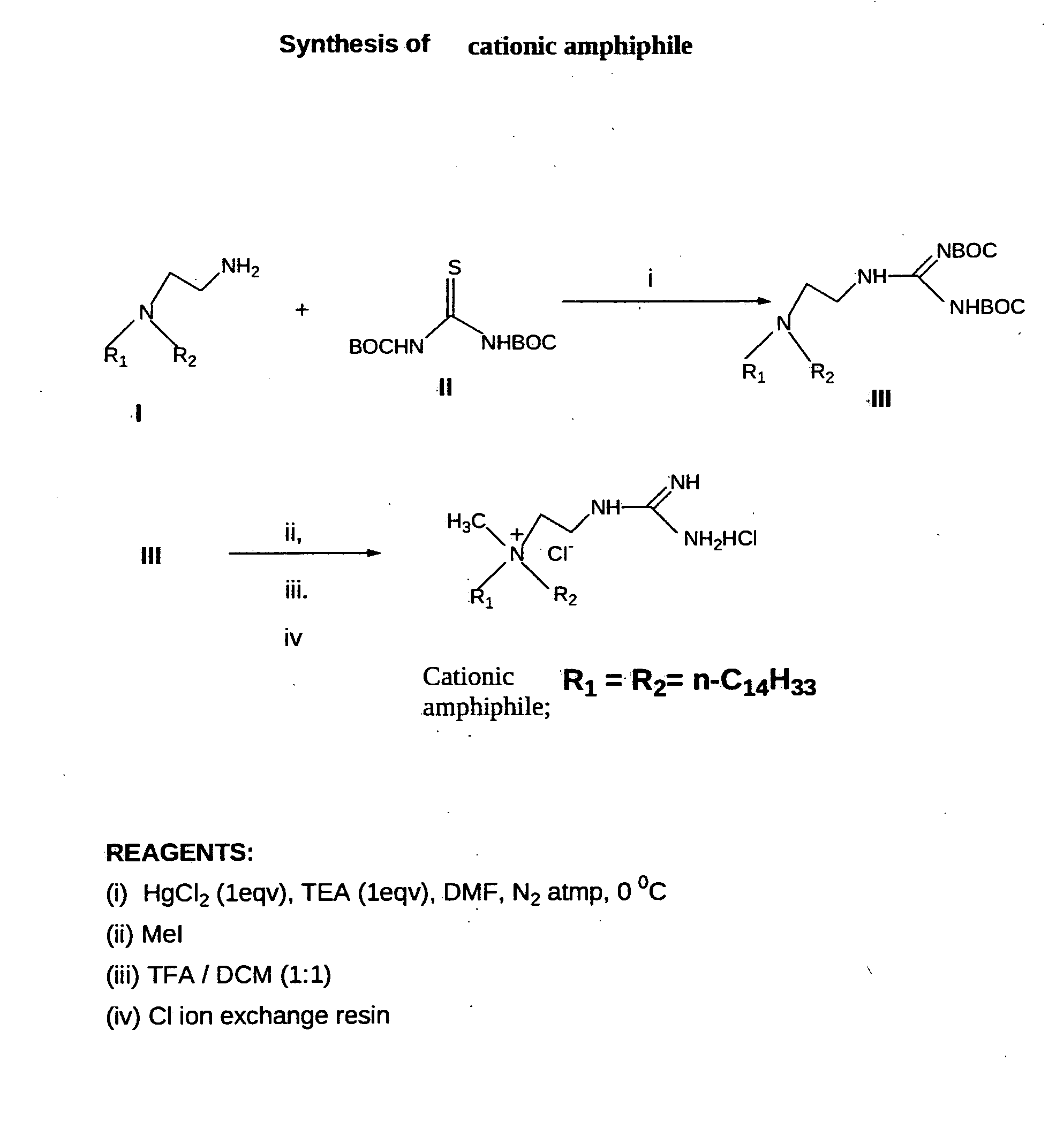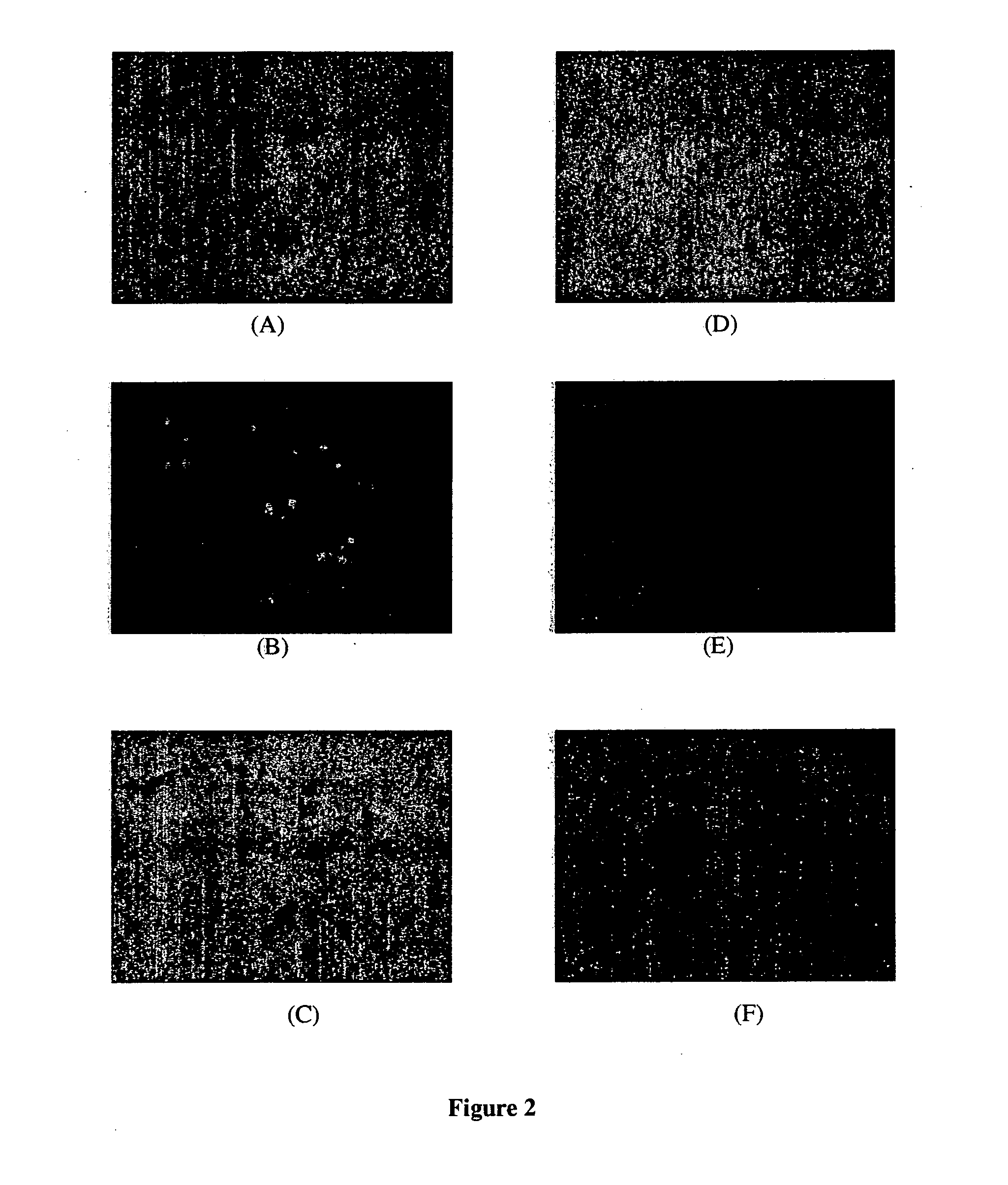Amphoteric liposomal compositions for cellular delivery of small RNA molecules for use in RNA interference
- Summary
- Abstract
- Description
- Claims
- Application Information
AI Technical Summary
Benefits of technology
Problems solved by technology
Method used
Image
Examples
example 1
[0102]Synthesis of the cationic amphiphile (FIG. 1). Cationic amphiphile was synthesized following the procedures depicted schematically in FIG. 1.
[0103]Synthesis of Cationic Amphiphile
[0104]Step-i. Synthesis of N,N-di-n-tetradecyl-N-[2-(N′,N′-di-tertbutoxycarbonyl-guanidinyl]ethyl amine (III, FIG. 1). Mercuric chloride (0.28 g, 1.0 mmol) was added to a mixture of N-2-aminoethyl-N,N-di-n-tetradecylamine (I, 0.49 g, 1.1 mmol), bis-N-Boc-thiourea (II, 0.08 g, 1.1 mmol, prepared conventionally by reacting one equivalent of thiourea with 2 equivalents of Boc-anhydride in presence of 2 equivalents of sodium hydride in anhydrous tetrahydrofuran at temperature of 0-2 degrees C. under stirring) and triethylamine (0.21 g, 2.1 mmol) dissolved in dry DMF (5 ml) and dry DCM (2 ml). The resulting mixture was stirred at 0° C. under nitrogen atmosphere for 40 minutes, diluted with ethyl acetate (20 ml) and filtered through a pad of celite. The filtrate was sequentially washed with water (2×20 ml) ...
example 2
[0112]Evaluation of siRNA delivery efficacies of the amphoteric composition containing N,N-di-n-tetradecyl-N-[2-guanidinyl]ethyl-N-methylammonium chloride (FIG. 1) done in four cells including COS-1, RAW264.7, CHO and HepG2 cells.
[0113]Cells were seeded at a density of 40,000 cells / well in a 24-well plate for 18 hrs before transfection in 500 μl of growth medium such that the well became 30-50% confluent at the time of transfection. For each well to be transfected, siRNA duplex-Liposome complexes were prepared as follows:
[0114]a) 20 pmol fluorescently labeled siRNA duplex namely, control(non-sil) siRNA, Fluorescein (Catalog No. 1022079, QIAGEN, USA) was diluted in 50 μl Opti-MEM® I reduced serum Medium without serum in the well of the tissue culture plate and was mixed gently.
[0115]b) Liposomes were prepared by dissolving the cationic amphiphile and the neutral co-lipid, i.e., cholesterol in the appropriate mole ratio in a mixture of methanol and chloroform in a glass vial. The solv...
example 3
[0117]Knocking down the expression of firefly luciferase GL2 gene in CHO cells by delivering luciferase GL2 siRNA with the help of the formulation containing equimolar amounts of N,N-di-n-tetradecyl-N-[2-guanidiny]ethyl-N-methylammonium chloride (cationic amphiphile, FIG. 1) and cholesterol.
[0118]One day before transfection, cells were seeded at 1×104 cells / well in 96-well plates with 100 μl of growth medium containing 10% FBS medium and incubated for 24 hrs. Cells were 50-60% confluent before transfection. The complex of luciferase GL2 siRNA, liposome and pCMV-GL2 Luciferase plasmid (obtained as a generous gift from the laboratory of Professor Leaf Huang, University of North Carolina, Chapel Hills, USA) was prepared as follows:[0119]a. 5-50 pmol luciferase GL2 siRNA duplex was diluted in 25 μl Opti-MEM® I Reduced
[0120]Serum[0121]Medium without serum and was mixed gently.[0122]b. Liposomes prepared using equimolar cationic amphiphile and cholesterol was mixed gently before use. 1.38...
PUM
| Property | Measurement | Unit |
|---|---|---|
| Temperature | aaaaa | aaaaa |
| Time | aaaaa | aaaaa |
| Time | aaaaa | aaaaa |
Abstract
Description
Claims
Application Information
 Login to view more
Login to view more - R&D Engineer
- R&D Manager
- IP Professional
- Industry Leading Data Capabilities
- Powerful AI technology
- Patent DNA Extraction
Browse by: Latest US Patents, China's latest patents, Technical Efficacy Thesaurus, Application Domain, Technology Topic.
© 2024 PatSnap. All rights reserved.Legal|Privacy policy|Modern Slavery Act Transparency Statement|Sitemap



